Kenneth C. Davis's Blog, page 73
October 17, 2015
Don’t Know Much About Benedict Arnold and His Boot
Why is there a statue of Benedict Arnold’s boot?
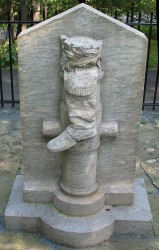
Statue of Benedict Arnold’s Boot at Saratoga National Historical Park
There it is — part of the Saratoga National Historical Park in Saratoga, New York. The “boot” is actually anonymous, citing the “most brilliant soldier in the Continental Army.”
On October 17, 1777, the British under General Burgoyne surrendered to American rebel troops led by Horatio Gates in one of the most significant turning points of the American Revolution.
But there is no question this marker honors American history’s greatest villain.
History books like to make people into heroes or villains. And Benedict Arnold was easily characterized as a villain, the most notorious traitor in American History for his attempt to betray the patriot cause when he was in command of the strategic post at West Point, overlooking the Hudson River. But he might have been one of the nation’s greatest heroes. And that is what makes history so compelling. Not the black and white of dates and “facts,” but the more subtle gray complexities of ego, ambition and human frailty.
Born on January 14, 1741 in colonial Norwich, Connecticut, Arnold had a biography that reads like that of a character out of Dickens. The son of a wealthy, successful ship’s captain and merchant, young Benedict Arnold was born with the proverbial silver spoon in his mouth. He was sent off to the best boarding school by his father, owner of the finest home in town. Then it fell apart. Yellow fever took his sisters while he was at school. Alcoholism then took his father. The fall was stunning as the elder Arnold became the town drunk and lost his fortune. At 14, young Benedict Arnold became an indentured servant. As a teenager, he ran away on several occasions to try and join the British-American forces then fighting France in the French and Indian War. Through pluck and generous relatives, Arnold eventually became a wealthy young merchant himself and was soon immersed in patriot politics, even traveling to Philadelphia to observe the First Continental Congress.
When the fighting began in 1775, he led Connecticut’s militia to Boston to join the rebel army gathering there. Arnold soon won honors for his role in the capture of Fort Ticonderoga on Lake Champlain. With George Washington’s approval, he led a daring but disastrous march through Maine to unsuccessfully attack Quebec. Later, he built a small navy to battle the British on Lake Champlain, helping save the patriot cause. But it was at Saratoga in October 1777 that he made his greatest contribution, leading a charge that turned the tide in what would become the most important American victory of the Revolution to that point.
During that charge, he was wounded in the leg and the injury caused a limp that would last his life. The statue recognizes Arnold’s wound and his central role in the victory at Saratoga without naming him.
Admired by Washington, Arnold also made a great many enemies. Seeing others promoted and advanced before him made him bitter and ultimately led to his fateful decision to join the British side.
After his plot was uncovered, Arnold did join the British side, fighting against his onetime countrymen. He led an assault on Virginia that nearly captured Governor Thomas Jefferson in 1781.
Arnold later moved to Canada and eventually to London where he died and was buried in June 1801 at the age of 60. His remains were accidentally –and fittingly?– moved to an unmarked grave.
You can read more about Arnold and his exploits in the chapter called “Arnold’s Boot” in America’s Hidden History and about the last day’s of the Revolution and Arnold’s role in The Hidden History of America At War.

The Hidden History of America At War (Hachette Books Random House Audio)
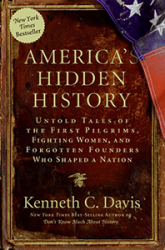
America’s Hidden History, includes tales of “Forgotten Founders”
October 14, 2015
Don’t Know Much About® “Ike”
Born on October 14, 1890 in Denison, Texas, Dwight D. Eisenhower, the 34th President of the United States.
The greatest hero of World War II as Supreme Commander of the Allied Expeditionary Forces in Europe and architect of America’s victory over Germany, Eisenhower was sought by both political parties, which hoped that he would join their ticket in 1948. President Truman even offered to run in second place as vice president if Eisenhower would join the Democratic ticket. He turned Truman down and then ran as a Republican in 1952, winning the first of two terms.
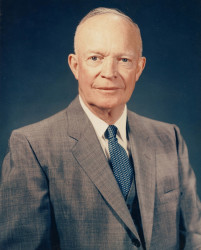
President Eisenhower (Courtesy: Eisenhower Presidential Library and Museum)
Milestones in Dwight D. Eisenhower’s Life
October 14, 1890 Born in Denison, Texas
1917–1918 Commander, U.S. Army Tank Training School
1932–1935 Senior military assistant to General Douglas MacArthur, U.S. Army chief of staff
1935–1939 Senior military assistant to General MacArthur in the Philippines
1941 Chief of Staff, Third Army
1942 Commanding general, U.S. Forces in Europe
1943–1945 Supreme commander, Allied Expeditionary Forces in Europe
1945–1948 Chief of staff, U.S. Army
1948–1950 President of Columbia University
1951–1952 Supreme commander of NATO Forces in Eu rope
1953–1961 Thirty- fourth president
March 28, 1969 Died at Walter Reed Army Hospital in Washington, D.C., aged seventy- eight. (Eisenhower’s New York Times obituary)

Young Eisenhower at Camp Meade (Photo: US Army, Public Domain Source: Eisenhower Presidential Library and Museum)
The Eisenhower Presidential Library and Museum is located in Abilene, Kansas.
Fast Facts
✱ Eisenhower was the last president born in the nineteenth century.
✱ Ike played army football, but his career was cut short by a broken leg, and so he became a cheerleader instead. No pom-poms.
✱ Eisenhower was the first president to be constitutionally prevented from standing for reelection following ratification of the Twenty-second Amendment; the amendment originated, according to journalist Tom Wicker, “in the Republican Eighty- second Congress as partisan, posthumous revenge against a hated Democrat, Franklin D. Roosevelt, and his four terms.”
✱ The last two of the fifty states were admitted under Eisenhower: Alaska (January 1959) and Hawaii (August 1959).
✱ At seventy, Eisenhower was the oldest president at that time; the youngest elected president, John F. Kennedy, succeeded him.
✱ During his presidency, Eisenhower suffered both a heart attack and a stroke, and was temporarily incapacitated. However, news of both health problems was made public, unlike Woodrow Wilson’s stroke. The Twenty- fifth Amendment, which revised and clarified the rules of presidential succession and allowed for temporary disabilities, was not ratified until 1967, and while Vice President Nixon was acting as executive, he lacked real constitutional authority to do so.
Initially dismissed by historians as a complacent, “do-nothing” president who slept through eight years in office, Eisenhower has moved up the ranks in more recent historical judgments. In Don’t Know Much About® the American Presidents, he received a “A” grade, although he is most faulted for his reluctance to be more forceful in the area of civil rights.
In early October 2014, a planned memorial to Eisenhower in Washington, D.C., which has been the subject of an ongoing controversy over its design, cost and size, received final approval from the National Capital Planning Commission. Conservative columnist George Will calls it a “monstrosity.”
Read more about Eisenhower’s life and administration in Don’t Know Much About® the American Presidents. Eisenhower plays a prominent role in a chapter of my new book, The Hidden History of America at War: Untold Tales from Yorktown to Fallujah (Hachette Books and Random House Audio).

Don’t Know Much About® the American Presidents (Hyperion Paperback-April 15, 2014)

“A fascinating exploration of war and the myths of war. Kenneth C. Davis shows how interesting the truth can be.” –Evan Thomas, New York Times-bestselling author of Sea of Thunder and John Paul Jones
October 6, 2015
Columbus From Hero to Zero (#SSchat)
Once Columbus was an intrepid hero with a federal holiday in his honor. Not so much anymore.

Here’s the bigger question: How do we deal with changing attitudes toward one-time heroes who are being reassessed in the classroom?
Lowering the Confederate flag, changing currency, removing statues of Confederate leaders such as Nathan Bedford Forrest and Jefferson Davis.
Yale University is questioning the , high priest of white supremacy.
But if harsh treatment of American Indians and slavery have become unpardonable sins, what do we do with the other heroes of American history who are linked inextricably to America’s slaveholding past and genocidal Indian policies?
How far do we go in revising our hero-worship in this new mood of removing the stain of America’s original sin?
Most important how do we teach these changing attitudes? Here are some of the other questions we will ask:
Q1: It’s Columbus Day; How do you discuss Columbus and his role in your classrooms today?
Q2; Should we rename Columbus Day?
Q3: There is a move to add a woman to the ten dollar bill. Many argue that Jackson should go instead? Is this a classroom topic for you?
Q4: 5 of first 7 presidents, 10 of first fifteen were slaveholders. How do you deal with this issue as it relates to Presidents like Jefferson and Jackson?
Q5: Army bases are named for Confederate generals. Should they be changed?
Q6: Is the Geography textbook that called African slaves “workers” a topic of discussion in your classroom?
I hope you will join us for lively conversation.
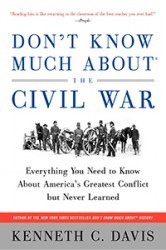
Don’t Know Much About the Civil War (Harper paperback, Random House Audio)

Don’t Know Much About History (Revised, Expanded and Updated Edition)

New York Times Bestseller
America’s Hidden History
Columbus Day-The World Is a Pear
(Video edited and produced by Colin Davis; originally posted October 2011)
“In fourteen hundred and ninety-two/Columbus sailed the ocean blue.”
We all remember that. But after that basic date, things get a little fuzzy. Here’s what they didn’t tell you–
*Most educated people knew that the world was not flat.
*Columbus never set foot in what would become America.
*Christopher Columbus made four voyages to the so-called New World. And his discoveries opened an astonishing era of exploration and exploitation. But his arrival marked the beginning of the end for tens of millions of Native Americans spread across two continents.
In 1892, the 400th anniversary of the arrival of Columbus inspired the composition of the original Pledge of Allegiance and a proclamation by President Benjamin Harrison describing Columbus as “the pioneer of progress and enlightenment.” (Source: Library of Congress, “American Memory: Today in History: October 12”)
That was the patriotic American can-do spirit behind the Columbian Exposition—also known as the Chicago World’s Fair of 1893.
In 1934, the “progress and enlightenment” celebrated in the Columbus narrative was powerful enough to merit a federal holiday on October 12 – a reflection of the growing political clout of the Knights of Columbus, a Roman Catholic fraternal organization that fought discrimination against recently arrived immigrants, many of them Italian and Irish.
Once a hero. Now a villain. Cities and states around the country are changing the name of the holiday to “Indigenous People’s Day” or “Native American Day” to move this holiday away from a man whose treatment of the natives he encountered included barbaric punishments and forced labor. Seattle joined the move to swap Columbus Day
You can read more about Christopher Columbus, his voyages and their impact on American history in Don’t Know Much About History and Don’t Know Much About Geography.
The story of “Isabella’s Pigs,” and the role of Queen Isabella in the making of the New World, is depicted in America’s Hidden History
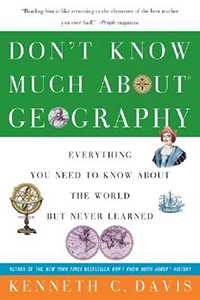
Don’t Know Much About® Geography (Revised and Updated Edition-Harper Perennial and Random House Audio)
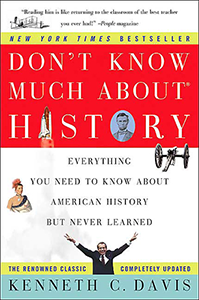
Don’t Know Much About® History: Anniversary Edition (Harper Perennial and Random House Audio)

October 5, 2015
Who Said It? (10/5/15)
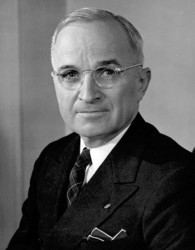
President Harry S. Truman
(Photo: Truman Library)
President Harry S. Truman in the first-ever televised address from the White House (October 5, 1947).
As post-war Europe struggled to recover, Truman asked Americans to refrain from eating meat and eggs on different days to help stockpile food supplies. The effort was mostly symbolic and was a prelude to the far more ambitious Marshall Plan which had a much greater impact on post-World War II Europe.
The food-saving program which has just been presented to you has my wholehearted support. I am confident that it will have the support of every American.
The situation in Europe is grim and forbidding as winter approaches. Despite the vigorous efforts of the European people, their crops have suffered so badly from droughts, floods, and cold that the tragedy of hunger is a stark reality.
The nations of Western Europe will soon be scraping the bottom of the food barrel. They cannot get through the coming winter and spring without help–generous help-from the United States and from other countries which have food to spare.
I know every American feels in his heart that we must help to prevent starvation and distress among our fellow men in other countries…
It is simple and straightforward. It can be understood by all. Learn it–memorize it–keep it always in mind. Here it is: One: Use no meat on Tuesdays.
Two: Use no poultry or eggs on Thursdays.
Three: Save a slice of bread every day.
Four: Public eating places will serve bread and butter only on request.
Complete Text and Source: “Radio and Television Address Concluding a Program by the Citizens Food Committee,” October 5, 1947. Online by Gerhard Peters and John T. Woolley, The American Presidency Project.
Read more about Truman and the post war world in Don’t Know Much About the American Presidents, Don’t Know Much About History and The Hidden History of America At War.
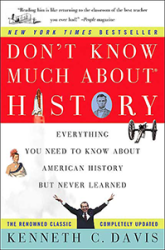
Don’t Know Much About® History: Anniversary Edition (Harper Perennial and Random House Audio)


Don’t Know Much About® the American Presidents (Hyperion Paperback-April 15, 2014)
October 4, 2015
Who Said It (9/30/2015)
…observe the last Thursday of November next, as a day of Thanksgiving…
ANSWER: President Abraham Lincoln, “Proclamation for Thanksgiving” (October 3, 1863)

Abraham Lincoln (November 1863) Photo by Alexander Gardner
President Abraham Lincoln, “Proclamation for Thanksgiving” (October 3, 1863)
I do therefore invite my fellow citizens in every part of the United States, and also those who are at sea and those who are sojourning in foreign lands, to set apart and observe the last Thursday of November next, as a day of Thanksgiving and Praise to our beneficent Father who dwelleth in the Heavens. And I recommend to them that while offering up the ascriptions justly due to Him for such singular deliverances and blessings, they do also, with humble penitence for our national perverseness and disobedience, commend to His tender care all those who have become widows, orphans, mourners, or sufferers in the lamentable civil strife in which we are unavoidably engaged, and fervently implore the interposition of the Almighty Hand to heal the wounds of the nation and to restore it as soon as may be consistent with the Divine purposes to the full enjoyment of peace, harmony, tranquility, and Union.
Full Text and Source: Teaching American History
Lincoln’s Proclamation is considered the first in a string of unbroken Presidential Thanksgiving Proclamations. Note well that there is no reference to the Pilgrims, Plymouth or the “First” Thanksgiving, which occurred sometime in October 1621.
For more on the first Thanksgiving, check out this video blog and Pop Quiz or read Don’t Know Much About the Pilgrims (HarperCollins)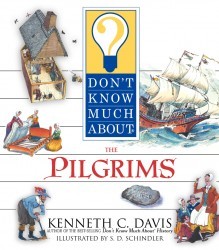
September 30, 2015
Who Said It (9/30/2015)
…observe the last Thursday of November next, as a day of Thanksgiving…

Abraham Lincoln (November 1863) Photo by Alexander Gardner
President Abraham Lincoln, “Proclamation for Thanksgiving” (October 3, 1863)
I do therefore invite my fellow citizens in every part of the United States, and also those who are at sea and those who are sojourning in foreign lands, to set apart and observe the last Thursday of November next, as a day of Thanksgiving and Praise to our beneficent Father who dwelleth in the Heavens. And I recommend to them that while offering up the ascriptions justly due to Him for such singular deliverances and blessings, they do also, with humble penitence for our national perverseness and disobedience, commend to His tender care all those who have become widows, orphans, mourners, or sufferers in the lamentable civil strife in which we are unavoidably engaged, and fervently implore the interposition of the Almighty Hand to heal the wounds of the nation and to restore it as soon as may be consistent with the Divine purposes to the full enjoyment of peace, harmony, tranquility, and Union.
Full Text and Source: Teaching American History
Lincoln’s Proclamation is considered the first in a string of unbroken Presidential Thanksgiving Proclamations. Note well that there is no reference to the Pilgrims, Plymouth or the “First” Thanksgiving, which occurred sometime in October 1621.
For more on the first Thanksgiving, check out this video blog and Pop Quiz or read Don’t Know Much About the Pilgrims (HarperCollins)
September 23, 2015
Christmas Riot, Bible Riots, Orange Riots-America When the Pope Was Not Welcome
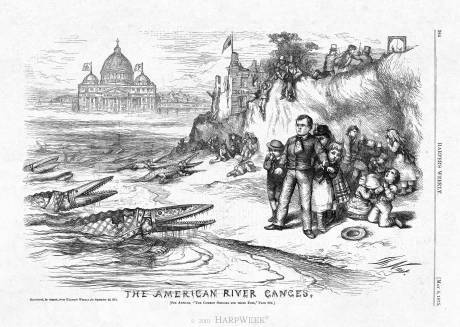
The American River Ganges by Thomas Nast (Originally published 1875- Source: HarpWeek Cartoons)
As New York and Philadelphia prepare for the Pope’s arrival, perhaps it is a good thing that famed cartoonist Thomas Nast is no longer wielding his acid-dipped pen. Or that Samuel F.B. Morse is not the Mayor who rolls out New York’s papal red carpet
Best known for his attacks on Tammany Hall, Nast was virulently anti-Catholic and anti-immigrant. One of his most notorious illustrations depicted crocodiles emerging from “The American River Ganges” with mouths formed of bishop’s miters and wearing Catholic vestments. (Above)
Back in 1836, Morse –not yet famous or wealthy as the man behind the telegraph and code that bear his name—was a prominent portrait painter who also taught at New York University. That year, Morse ran for Mayor of New York as the Nativist candidate, believing that “Popery” was a “system of the darkest political intrigue and despotism.”
Morse’s anti-Papist feelings had apparently been heightened during a visit to Rome when the American painter refused to doff his hat as the Pope passed and a Vatican guard knocked it to the ground.
Samuel Morse did not win City Hall in 1836. But it was not due to the virulence of his anti-Catholic, anti-immigrant positions. In fact, these were widely held popular views across much of nineteenth-century America. The belief then was that Catholics, and specifically the waves of Irish immigrants, would destroy American democracy and turn the country over to the Pope who would occupy a new Vatican to be built in Cincinnati. That was not a fringe view but a mainstream notion preached in prominent pulpits by such men as Lyman Beecher, father of Henry Ward Beecher and Harriet Beecher Stowe.
This anti-Catholic venom was an accepted American truism long before the nation’s birth –a deep sectarian divide with roots in Europe’s deadly wars between Catholic and Protestant. The hatred of all things Roman Catholic was part of America’s Puritan and Protestant roots.
But the fear and loathing of Catholics went beyond sermons. It had led to some notable violence. In 1806, a New York Nativist gang attacked worshippers leaving church after midnight mass on Christmas Eve. In what became known as the “Christmas Riots,” the Irish Catholics fought back the next day in a skirmish that left a city watchman dead and led to Nativist reprisals on Irish neighborhoods.
And it was not just New York. The Ursuline convent outside Boston was attacked and burned in 1834. 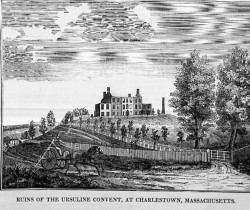
In 1844, Philadelphia saw anti-Catholic, anti-Irish hatred boil over in the Bible Riots that left dozens dead and churches and homes in flames.
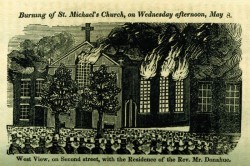
“A Full and Complete Account of the Late Awful Riots in Philadelphia”: Burning of St. Michael’s Church, on Wednesday afternoon, May 8
Historical Society of Pennsylvania
Waves of Irish immigrants later transformed New York’s politics. William Tweed would use their votes to secure power for Tammany Hall and himself. But the growth of Irish Catholic power in New York only deepened ancient animosities.
New York’s virulent anti-Catholic sentiment peaked most violently with the largely overlooked “Orange Riots” of 1870 and 1871. In the first of these, Irish Protestants marched in celebration of the July 12, 1690 victory of the Protestant King William III over Catholic King James II at the Battle of the Boyne. Taunting Irish Catholic workmen as they paraded up Eighth Avenue, the Protestant “Orangemen” went to a park where a pitched battle ensued. Eight people died.

The Orange Riot of 1871 as depicted in Frank Leslie’s Illustrated Newspaper. The view is at 25th Street looking south down Eighth Avenue (Source Wikipedia: https://en.wikipedia.org/wiki/Orange_...)
An “Orange Day” march planned in 1871 was nearly banned. But prominent businessmen and cartoonist Thomas Nast objected vehemently to this affront to Protestant rights. With Boss Tweed guaranteeing protection for the marchers, the 1871 parade stepped off, guarded by some 5,000 policemen and National Guard militia units. Almost immediately, the marchers were pelted with bottles, bricks, shoes and stones. Pitched battles continued along the parade route. When it was over, the rioting and street-fighting left sixty people dead, most of them Irish Catholic laborers as well as three Guardsmen.
The bloodshed of the successive “Orange Riots” and Tweed’s failure to secure the parade were crucial factors in the demise of his stranglehold on New York. The city’s newspapers and largely Protestant-controlled business and financial world turned on him. Tweed was deposed, eventually arrested and later convicted of corruption.
The deep enmity towards Catholics was alive and well when John F. Kennedy ran for president in 1960. He confronted questions of his faith in a memorable speech in Texas.
I believe in an America where the separation of church and state is absolute, where no Catholic prelate would tell the president (should he be Catholic) how to act, and no Protestant minister would tell his parishioners for whom to vote; where no church or church school is granted any public funds or political preference; and where no man is denied public office merely because his religion differs from the president who might appoint him or the people who might elect him.
But that did not stop New York’s most prominent Protestant voice, Norman Vincent Peale, from opposing him. Peale had very few positive thoughts about Kennedy’s faith. Working with Billy Graham and other Protestant clergy, Peale vigorously sought to defeat Kennedy –solely on the basis of his Catholic faith. “Faced with the election of a Catholic,” Peale was quoted in Newsweek, “our culture is at stake.”
As the Pope makes what will be a largely celebratory visit to New York –where almost everyone now pretends to be Irish for a day honoring the patron saint who brought Catholicism to Ireland – these reminders of America’s dark anti-Catholic past are an important corrective. The Pope’s sojourn in the Big Apple comes as the question of religion has been thrust into the political spotlight again. Republican contender Ben Carson told NBC’s “Meet the Press” that Islam was “not consistent with the Constitution.”
Once upon a time in America, it was Catholics whose faith was the sinister religion that Americans feared. The Pope, not the Ayatollah, was the threat to American democracy.
So welcome to America, Pope Francis. Say hello to the Statue of Liberty where we still talk a pretty good game about those “huddled masses yearning to breathe free.”
The subject of America’s anti-Catholic history is treated 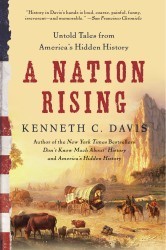 in my books America’s Hidden History and A Nation Rising.
in my books America’s Hidden History and A Nation Rising.

America’s Hidden History, includes tales of “Forgotten Founders”
September 21, 2015
Who Said It (9/21/20150

Mob rule cannot be allowed to override the decisions of our courts.
President Eisenhower (Courtesy: Eisenhower Presidential Library and Museum)
President Dwight D. Eisenhower, “Radio and Television Address to the American People on the Situation in Little Rock”
(September 24, 1957)
In that city, under the leadership of demagogic extremists, disorderly mobs have deliberately prevented the carrying out of proper orders from a Federal Court. Local authorities have not eliminated that violent opposition and, under the law, I yesterday issued a Proclamation calling upon the mob to disperse.
This morning the mob again gathered in front of the Central High School of Little Rock, obviously for the purpose of again. preventing the carrying out of the Court’s order relating to the admission of Negro children to that school….
They thus demonstrated to the world that we are a nation in which laws, not men, are supreme.
I regret to say that this truth–the cornerstone of our liberties-was not observed in this instance…
The interest of the nation in the proper fulfillment of the law’s requirements cannot yield to opposition and demonstrations by some few persons.
Mob rule cannot be allowed to override the decisions of our courts.
Source and Complete Text: “Radio and Television Address to the American People on the Situation in Little Rock.,” September 24, 1957. Online by Gerhard Peters and John T. Woolley, The American Presidency Project.
Learn more about the Little Rock Crisis at the Little Rock Central High School National Historic Site. Read more in Don’t Know Much About® History and Don’t Know Much About® the American Presidents.

Don’t Know Much About® History: Anniversary Edition (Harper Perennial and Random House Audio)

Don’t Know Much About® the American Presidents (Hyperion Paperback-April 15, 2014)
September 20, 2015
Don’t Know Much About the “First Pilgrims”
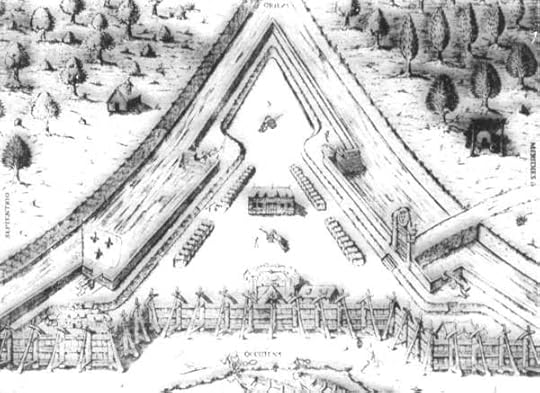
Old etching of Fort Caroline, from the Florida State Archives.
On September 20, 1565, 450 years ago, America’s first Pilgrims were wiped out in a dawn raid –a religious bloodbath — in what was then Spanish Florida. Leaving their base at the newly established St. Augustine, Spanish troops led by Admiral Menéndez assaulted the small French colony of Fort Caroline –near present-day Jacksonville,
Attacking before dawn on September 20, 1565 with the frenzy of holy warriors, the Spanish easily overwhelmed Fort Caroline. With information provided by a French turncoat, the battle-tested Spanish soldiers used ladders to quickly mount the fort’s wooden walls. Inside the settlement, the sleeping Frenchmen—most of them farmers or laborers rather than soldiers—were caught off-guard, convinced that no attack could possibly come in the midst of such a terrible storm. But they had fatally miscalculated. The veteran Spanish harquebusiers swept in on the nightshirted and naked Frenchmen who leapt from their beds and grabbed futilely for weapons. Their attempts to mount any real defense were hopeless. The battle lasted less than an hour.
Although some of the French defenders managed to escape the carnage, 132 soldiers and civilians were killed in the fighting in the small fort. The Spanish suffered no losses and only a single man was wounded. The forty or so French survivors fortunate enough to reach the safety of some boats anchored nearby, watched helplessly as Spanish soldiers flicked the eyeballs of the French dead with the points of their daggers.
Excerpt from America’s Hidden History
[Admiral] Menéndez had many of the survivors strung up under a sign that read, “I do this not as to Frenchmen but as to heretics.” A few weeks later, he ordered the execution of more than 300 French shipwreck survivors at a site just south of St. Augustine, now marked by an inconspicuous national monument called Fort Matanzas, from the Spanish word for “slaughters.”

Fort Matanzas Courtesy National Park Service
A brief account of this story is told in this New York Times Op-Ed, “A French Connection.”
The full story is recounted in “Isabella’s Pigs,” the first chapter of America’s Hidden History. An excerpt from this book, “America’s First True ‘Pilgrims,'” was published in Smithsonian magazine (May 2008).

America’s Hidden History, includes tales of “Forgotten Founders”



